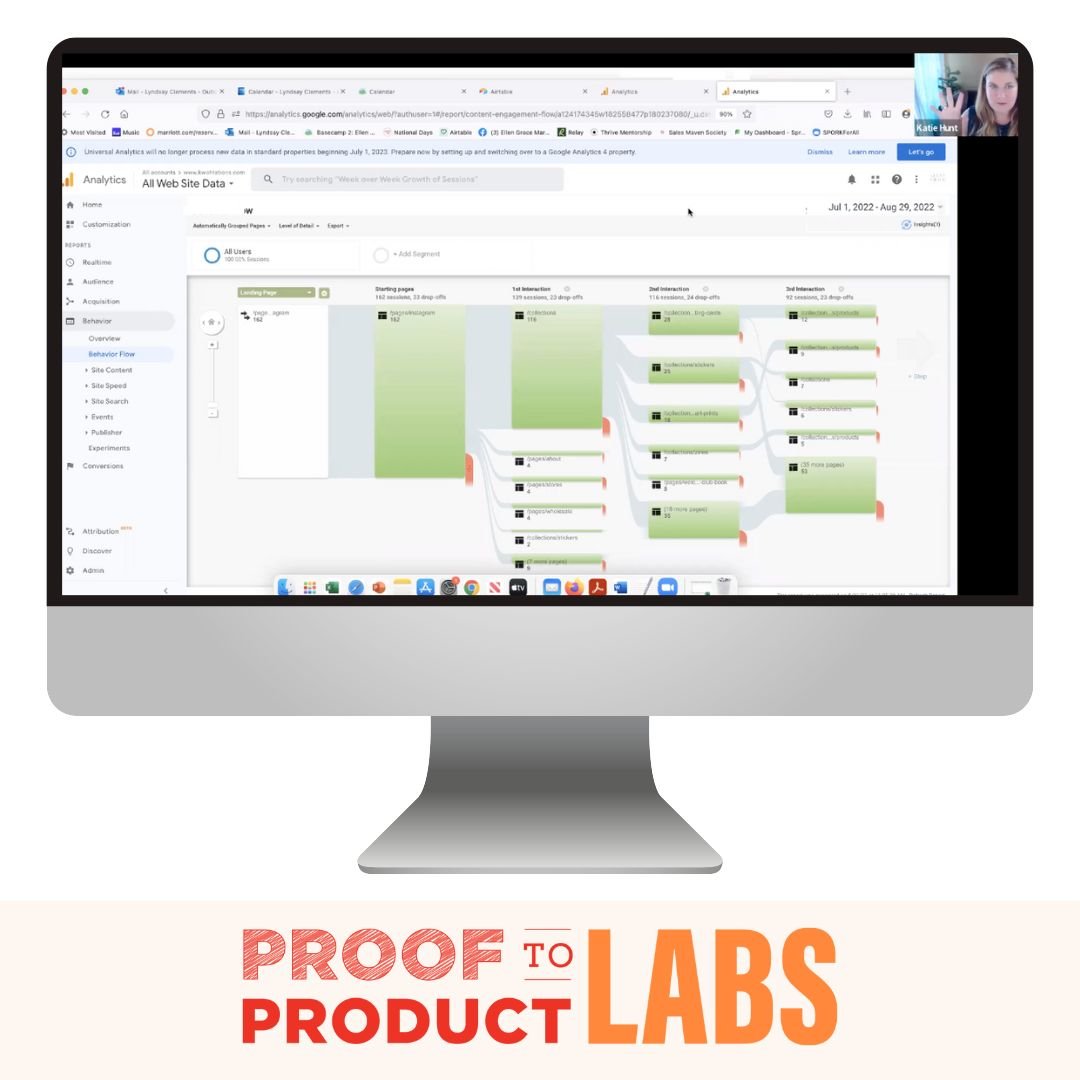120 | Managing a wholesale & retail e-commerce shop with Kaitlin Fontenot, Kait Studio
On Episode 120, Kaitlin and I sit down to talk about how to build an e-commerce website; what to prepare before building an e-commerce site, ways to manage both online wholesale and retail shops, and which platforms are best.
Kaitlin and I also discuss some misconceptions some product-based business owners have about e-commerce platforms and she shares a few important social media marketing strategies you definitely should start leveraging today.
We wrap up by talking about hiring, building a team with intention, and the importance of delegation.
How to Build an e-Commerce Website:
Kaitlin is the founder of Kait Studio where she works with e-commerce businesses to help develop and design websites to not only sell their products but also to help businesses and customers connect. She offers done-for-you services to help you build your website but we know that hiring a website designer is not always feasible. She breaks down some of the best tips for building your own e-commerce website.
First up, she says it is really important to see what problems your customers are currently facing on your website.
If you have a chatbox on your site, what questions are they asking?
What are your customers DMing you on social about?
Can they not find a certain collection or don’t know how to purchase from you?
Those are the types of things to prioritize when designing a website.
When Kaitlin and her team are developing or designing a website, the first step is always to map out a wireframe. A wireframe is essentially a screen blueprint, a map of what your website will look like.
Then, once you have the wireframe laid out, you can start implementing the design features and optimizing your website for more views and conversions.
Images on Your Website
Images are one of the most important things you can include on your e-Commerce website.
If you can, budget for getting quality photos taken of your products, or if you are selling products from other vendors, consider having photos taken of those products so you can create your own brand. You want people to look at a photo in their feed and say “I know that brand.” This might mean not using vendor images.
If you are on a tight budget you can try taking your own product photos.
A benefit to taking your own photos is the ability to test different backgrounds, layouts, and vibes to see what resonates with your audience. You can test this on social media or with two different Pin images to see which one drives more traffic to your website.
Where to build an e-commerce website
There are numerous platforms to consider when building your e-commerce website:
Shopify (affiliate link!)
Bigcommerce
Woocommerce
Squarespace
Wix
Kait works exclusively with Shopify because it is ideal for building a beautiful, functional, and intentional website. However, Woocommerce is an option, especially for smaller stores or those dealing primarily with digital downloads.
Should I separate my Wholesale and Direct to Consumer Websites?
A common question of business owners is whether or not to house their wholesale and direct-to-consumer stores on the same site.
The answer depends on how much product you have. If you are selling the same amount of product to wholesale customers as direct-to-consumer customers, then house them on separate sites.
The benefit of separate sites is you can see data more clearly. Steel Petal Press does a great job of clearly calling out which site you are on with a link to the other site in case purchasers end up on the wrong site.
If you have a small wholesale side of your business (less than 10 products), Kait suggests keeping them on the same site as it is a bit easier to manage one site than two plus it can also be more cost-effective.
Converting Website Viewers to Customers
Visitors to your e-Commerce website are great but what we really want is to convert those viewers into customers.
The number one struggle Kait sees when business owners launch a website is that they stay focused on the website instead of moving on to other strategies.
Business owners often operate under the “build it and they will come” assumption. Then, once they build the website and customers don’t immediately flock to it, the owners start to change images, product descriptions, or layouts in hopes that something will happen.
Instead, as Kait says, step away from the website and see what else you can do to get visitors to your website.
Utilizing Pinterest to Drive Traffic to Your website
One way to increase your web traffic is by using Pinterest. Implementing a small Pinterest ad campaign with as little as $30 can drive significant traffic to your website. By using two different product photos in your ad (same product, different photos), you can get quick feedback on which image performs better with your audience.
Once customers are on your site, you can see what they are doing, the pages they visit, and how they are converting.
Inside our LABS membership, we have trainings on implementing Pinterest ads as well as a training on understanding Google Analytics and what your visitors are doing on your website.
Utilizing Instagram to Drive Traffic to Your Website
Instagram stories, reels, and Tik-Tok videos are also other valuable places to spend time. Customers want to see the behind-the-scenes of your business and your product.
Kait shared some really valuable tips to implement in your Instagram strategy:
Tag your city
Tag the city you want to target, not your physical store. If they don’t know your store exists, they will never find your hashtag but if they search a city you are targeting, you are more likely to pop up.
Implement hashtags
Spend time researching various hashtags for your niche. You can quickly go from 300 to 400 views on a story to 10,000 just by using hashtags that our audience is already viewing.
For example, if you are selling home decor products, use the tags that your audience is looking at. Kait shares #studiomcgee is a popular interior design hashtag. By using that hashtag, you are more likely to show up in the feed of new viewers.
When researching hashtags, look at accounts for people in your niche to help conduct your hashtag research. Kait recommends staying away from your competitors or other retailers. Instead, if you sell home decor items, go to interior designers' Instagram pages to see what hashtags they are using. Keep your hashtags between 30k and 300k users.
Kait also recommends Chalene Johnson as a valuable resource for hashtag research.
When adding hashtags to your story, type them in and hide them behind your photo to keep your pictures looking clean while optimizing them for more views.
How to Delegate as a Business Owner
Kait and I switch gears and talk about delegating tasks as business owners since this is a key part of running a successful business.
We all do things in our business that we don’t have to have our hands on. Things like:
Social media scheduling
Web design
Inbox management
The key to delegating is to stay in your lane, focus on your customers, and build authentic relationships with your customers whether they are online or in person.
If you are ready to hire additional support ask for references. Look for someone who has done what you need to be done before. You don’t want to be anyone’s guinea pig. Ask lots of questions to ensure you are comfortable with them.
Our free training, Decide What to Delegate in 3 Simple Steps will walk you through three steps needed to figure out what tasks you need to delegate.
In Conclusion:
Not everyone needs to or has the ability to hire a website designer to create a website for them. That’s why knowing how to build an e-Commerce website, even just the basics, comes in handy.
These steps will help you get started:
Map out your website wireframe
Decide which platform to build on (Shopify is recommended for product-based businesses)
Build your e-Commerce website (remember to pay attention to what your customers are asking you to help drive direction for your website!)
Utilize photography to create a brand that others recognize
Launch your website and let it be for a while
Implement Pinterest marketing and social media to drive traffic to your site
Quick Links
Here is a quick recap of links shared in this post:
Creating great photos & social media content with Alisha Cohen, LISH Creative
How Rachel Ngom Got 34,000 More Views on Her Website Using Pinterest
Two Months on Tik Tok Led to 40% Rise in Website Traffic with Kyle Sommer
How to Take Professional Product Photos with Your Smart Phone with Chaitra Radhakrishna
Join us inside of LABS, our membership to help business owners with operations, sales, marketing, and product development
Check out our free training, Decide What to Delegate in 3 Simple Steps
Download These Quotables to Save and Share
KEY TAKE AWAYS
“If I had to pick one aspect of my business that I completely loved and was so passionate about, it would be the design development side” - Kaitlin Fontenot
“People would ask, “Who's growing your Instagram account? Who's helping you with all of this? Is it just you?” And I would just say, "Yeah, you know, it's me. I built the site. I'm doing all of this myself." - Kaitlin Fontenot
“You need to be leveraging your website in a very strategic way to not only get people coming through to your site, but to get them engaging with your products and purchasing your products and engaging with your brand.” - Katie Hunt
“You have to think about the amount of time people are spending on social media and how they're getting to your website. There's so much that goes into it, and you have to know your customer 100%.” - Kaitlin Fontenot
“I truly believe that if you're solving problems for people, especially through your website or your online shop, they will convert into paying customers.” - Katie Hunt
“Everyone's customers are different. Everyone's audience is different. So really, it's all about what your audience is responding to the most.” - Kaitlin Fontenot
“Once the build phase is done sometimes people get stuck. They don't move forward with any other strategies. So I always recommend the website is done, step away. Let's try some other things. Go to Instagram, go to Pinterest, see what you can do.” - Kaitlin Fontenot
“Hiring a team, it's really scary. But as a mom and a business owner, it has been the most life-changing thing for me.” - Kaitlin Fontenot
“I was doing everything myself for a very long time, had small children at home and when I started delegating and outsourcing, even just small pieces, it changed my life. I was able to do more in the business and focus on the high level strategic things that needed my attention.” - Katie Hunt
“Find someone you feel comfortable with, that's okay with answering your questions no matter how crazy you think they are. Find someone who understands where you're coming from because it is a big investment and anyone you work with should understand as a business owner themselves.” - Kaitlin Fontenot
LINKS
CONNECT WITH KAITLIN FONTENOT
Website: LoveKait | Instagram: KaitStudio | Personal Instagram: KaitlinFontenot

Connect with Katie Hunt
Katie Hunt is a business strategist, podcaster, mentor and mama to four. She helps product based businesses build profitable, sustainable companies through her conferences, courses and coaching programs.
Website: prooftoproduct.com | Instagram: @prooftoproduct














